Caroline Matilda of Great Britain
| Caroline Matilda of Great Britain | |
|---|---|
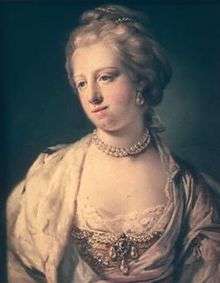 Pastel by Francis Cotes, 1766 | |
| Queen consort of Denmark and Norway | |
| Tenure | 8 November 1766 – 10 May 1775 |
| Born |
22 July 1751 Leicester House, London, England, Great Britain |
| Died |
10 May 1775 (aged 23) Celle, Holy Roman Empire |
| Burial |
13 May 1775 Stadtkirche St. Marien, Celle, Holy Roman Empire |
| Spouse | Christian VII of Denmark |
| Issue |
Frederick VI of Denmark Louise Augusta, Duchess of Schleswig-Holstein-Sonderburg-Augustenburg |
| House | Hanover |
| Father | Frederick, Prince of Wales |
| Mother | Princess Augusta of Saxe-Gotha |
Caroline Matilda of Great Britain (Danish: Caroline Mathilde; 22 July 1751 – 10 May 1775) was queen consort of Denmark and Norway by marriage to King Christian VII.
Early life
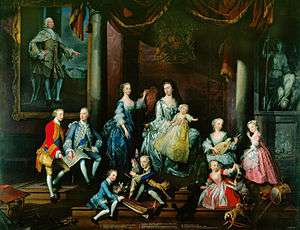
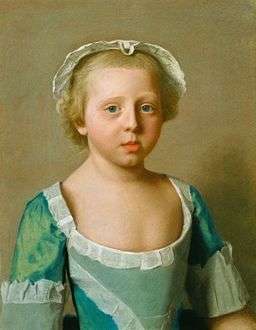
Caroline Matilda was the youngest child of Frederick, Prince of Wales, and Princess Augusta of Saxe-Gotha. Her father died suddenly about three months before her birth. She was born at Leicester House in London, and was given the style and title HRH Princess Caroline Matilda,[lower-roman 1] as daughter of the Prince of Wales, though, by the time of her birth, the title of Prince of Wales had passed to her brother George (who became George III in 1761). Both of her names were used due to her aunt, Princess Caroline, being alive. The princess was christened ten days later, at the same house, by The Bishop of Norwich, Thomas Hayter. Her godparents were her brother George, her paternal aunt Caroline and her sister Augusta.[2]
She was brought up by her strict mother away from the English court and was described as natural and informal. She enjoyed out-doors life and riding. She was musically gifted, could speak Italian, French and German, and was described as an accomplished singer with a beautiful voice.[3]
In 1764, negotiations were made between the British and Danish royal houses of a marriage between the Danish heir to the throne and a British princess. The marriage was considered suitable in status and welcomed by both houses, as there were few Protestant royal houses for either party to choose between at that point. The preferred choice for a bride was initially Princess Louisa, but after the Danish representative in London, Count von Bothmer, was informed of her weak constitution, her younger sister Caroline Matilda was chosen for the match instead.[4] The marriage was announced in Great Britain 10 January 1765.[5]
Marriage
In October 1766, at the age of fifteen, Caroline Matilda married by proxy her cousin, Christian VII of Denmark in Great Britain with a stand-in for the groom, and left for Denmark. Three weeks later, she arrived in Altona, where she left her British entourage and was welcomed by her appointed Danish courtiers. After twelve days, she was welcomed by Christian in Roskilde, were she was housed until the wedding. The second wedding ceremony took place on 8 November 1766 in the Royal Chapel at Christiansborg Palace in Copenhagen. Her eldest brother, by then King George III, was anxious about the marriage, although he was not fully aware that the bridegroom was mentally ill.
Caroline Matilda had two children, both of whom were officially recognized as the issue of Christian VII:
- Frederick VI of Denmark (1768–1839)
- Princess Louise Auguste of Denmark (1771–1843)
Queen of Denmark

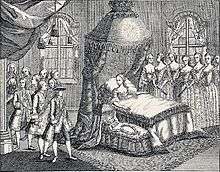
After the wedding, the marriage was celebrated with months of festivities and balls. As a person, Queen Caroline Matilda was described as temperamental, vivid and charming.[6] She was thought too plump to be described as beauty, but she was considered attractive: it was said of her that "her appearance allowed her to avoid criticism of women, but still captivate the male eye".[7] However, her natural and unaffected personality was not popular at the strict Danish court.[8]
Caroline Matilda became close to her Overhofmesterinde , Louise von Plessen, who regarded the King's friends, such as Conrad Holck and Enevold Brandt, as immoral and acted to isolate Caroline Matilda from her spouse. This was not difficult, as Christian did not like her. He reputedly preferred men and was not eager to consummate the marriage.[9] The couple was further estranged when Louise von Plessen advised Caroline Matilda to claim to be indisposed when the King expressed a wish to physical intimacy, with the thought that distance would make the King more eager; instead, though, it only made him more unwilling.[10] The Danish King was persuaded by his old tutor Reverdil to consummate the marriage for the sake of the succession, and after a son was born in January 1768, he turned his interest to the courtesan Støvlet-Cathrine, with whom he visited the brothels of Copenhagen.[11] The scandal of the King's behavior caused Støvlet-Cathrine to be exiled to Hamburg.
Caroline Matilda was unhappy in her marriage, neglected and spurned by the King. When Louise von Plessen was exiled from court in 1768, she lost her closest confidante, leaving her even more isolated. She refused to accept von Plessen's successor, Anne Sofie von Berckentin, whom she suspected her to have taken part in the plot to exile von Plessen. Thus, Plessen was not replaced until Margrethe von der Lühe agreed to accept the post in 1768.
In May 1768 Christian VII took his long tour of Europe, including stays in Altona, Paris and London. During his absence, Caroline Matilda aroused attention when she took walks in Copenhagen.[12] This was considered scandalous, as royal and noble Danish women normally only traveled in town by carriage.[13] Caroline Matilda spent the summer at Frederiksborg Castle with her new child before returning to Copenhagen in the autumn. During the absence of the King, there were rumors about the Queen and a certain La Tour, a handsome actor and singer from the French language theater Hofteatret.[14] La Tour was the lover of her lady-in-waiting Elisabet von Eyben, but he was noted to receive gifts from "a higher hand" and it was said that his visits to von Eyben's chamber were in fact visits to the Queen.[15] The allegation of an affair is not considered to have been true, but La Tour was exiled after the return of the King, perhaps because the rumor was damaging enough in itself.[16]
About this time, Caroline Matilda made friends with Christine Sophie von Gähler, Elisabet von Eyben, Anna Sofie Bülow and Amalie Sofie Holstein, who were known for their love affairs. According to the letter writer Luise Gramm, they encouraged her to participate more in social life, dance and flirt.[17]
Affair and scandal
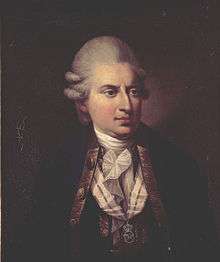

The King returned to Copenhagen on 12 January 1769, bringing with him Johann Friedrich Struensee as Royal Physician. He had met Struensee in Altona at the beginning of his travels. During 1769, the King's mental health deteriorated. Struensee could apparently handle the King's instability, which was a great relief to the King's advisers, and the King developed a confidence in him.
During 1769, Struensee encouraged the King in his attraction to Birgitte Sofie Gabel, reportedly because he believed a relationship with an intelligent woman would make the King more mentally stable and his insanity easier to handle, but this failed, and the attempt to provide the King with a mistress made the Queen hostile toward Struensee.[18]
After this, Struensee encouraged the King to improve his relationship with Caroline Matilda, and Christian VII showed his attention to her in the form of a three-day birthday party on 22 July 1769. The Queen was well aware that Struensee was behind these improvements, and her interest in the charming doctor developed. She was grateful that he improved the King's behavior toward her, thereby also improving her position at court. In the summer of 1769, she allowed him to tend to her during her illness upon the recommendation of the King. In January 1770, Struensee was given his own bedroom in the Christiansborg Palace and, by spring 1770, he was her lover.[19] A successful vaccination of the baby Crown Prince in May still further increased his influence.
During 1770, the King became more and more passive, isolated and less counted upon as his mental health deteriorated. He entrusted more and more of the daily state affairs to Struensee, as he had by then become accustomed to trust him.
During the summer of 1770, the King and Queen made a tour through the Duchies of Schlesvig-Holstein toward the German border, accompanied by Struensee. During the trip, the Queen and Struensee was observed to behave in a suspicious manner toward each other, and rumors started spreading that they were lovers.[20] In Lüneburg, Caroline Matilda met her mother, who reportedly cautioned her about the rumors spreading of the mental state of her spouse and of the fall of Prime Minister Bernstorff, in which Caroline Matilda was rumored to have participated.[21] Caroline Matilda received her in breeches, which at that time was regarded as scandalous.[22] To her mother's lamentations, she answered: "Pray, madam, allow me to govern my own kingdom as I please!" [23]
Upon the return of the royal couple to Copenhagen, Struensee had all the government ministers opposed to him replaced. On 15 September 1770 the King dismissed Bernstorff, and two days later Struensee became Maître des Requêtes (Privy Counsellor), consolidating his power and starting the 16-month period generally referred to as the "Time of Struensee". When, in the course of the year, the King sank into a condition of mental torpor, Struensee's authority became paramount, and he held absolute sway between 20 March 1771 and 16 January 1772.
During this time he issued no fewer than 1069 cabinet orders, or more than three a day. For this reason, he has been criticized for having an imprudent "mania" for reform. Another criticism of Struensee is that he did not respect native Danish and Norwegian customs, seeing them as prejudices and wanting to eliminate them in favour of abstract principles.
.jpg)
Nor were Struensee's relations with the Queen less offensive to a nation which had a traditional veneration for the royal house of Oldenburg, while Caroline Matilda's conduct in public brought the Crown into contempt. Her way of openly demonstrating her new happiness was seen as shocking, as when the couple reportedly barely concealed their affair during the masked balls of Caroline von Schimmelmann.[24] Caroline Matilda, until now without influence, became the center of the Court's attention, and gathered followers called Dronningens Parti (literary "The Queen's Party").[25] She gained a new confidence, and showed herself in public riding astride on horseback, dressed as a man. This was seen as scandalous, and according to Luise Gramm, she had been encouraged to this by her lady-in-waiting Elisabet von Eyben.[26] Struensee introduced a reform in which burgher class people were allowed to dine informally with the royal family, and the Queen acquired friends outside the aristocracy such as Johanne Marie Malleville, which was seen as a scandal.[27] On the King's birthday in January 1771, she founded the Mathildeordenen and distributed it to her and her lover's friends and supporters.
On 17 June 1771 the Court took summer residence at Hirschholm Palace in present-day Hørsholm municipality. Here, she lived happily with her child and her lover, and was painted with her son in the style of the newly modern country life by Peter Als; this summer is described as an idyll.[28] She also planned a new summer villa, Frydenlund in Vedbæk. On 7 July 1771, Caroline Matilda gave birth to her second child, Princess Louise Auguste, whose father was almost certainly Struensee. This was also considered scandalous; the girl was called “la petite Struensee”, though officially accepted as a princess.[29]
The Court moved to Frederiksberg Palace on 19 November and then back to Christiansborg Castle on 8 January 1772.
Divorce and exile
Struensee and Caroline Matilda were both arrested in the middle of the night between 16 and 17 January, after a masked ball at the Hofteatret at Christiansborg Palace. Caroline Matilda was taken to Kronborg Castle to await her judgment. She was allowed to keep her daughter with her, while 4 year old Crown Prince Frederik stayed with his father.
Caroline Matilda was not given any advisers.[30] She initially denied her relationship to Struensee in the hope of saving him.[31] She eventually admitted her guilt to the adultery with a signed statement[32] but she is believed to have been pressed or manipulated to admit the relationship by the interrogator.[33]
The marriage of Caroline Matilda and Christian was dissolved by divorce in April 1772. After the divorce, Johann Friedrich Struensee and his accomplice Count Enevold Brandt were executed for treason on 28 April 1772.
Caroline Matilda's brother, George III, sent Sir Robert Murray Keith, a British diplomat, to negotiate her release from imprisonment.[34] On 28 May 1772, Caroline Matilda was deported on board a British frigate to Celle, residing at Celle Castle in her brother's German territory of Hanover. She never saw her children again.
Later life in Celle
In Celle, Caroline Matilda resided with her own court at Celle Castle and became known for her charity toward poor children and orphans. She was also reunited with her former hofmesterinde (Mistress of the Robes) Countess Louise von Plessen.
In 1774, she became the center of a plot with the intent to make her the Regent of Denmark as the guardian of the Crown Prince, instigated by Ernst Schimmelmann with the Englishman Nathaniel Wraxall as a messenger.[35] Wraxall met her many times and she used him as messenger to her brother George III, whose support she desired.[36] She herself wrote a letter to her brother in 1775, in which she asked for his approval for the plan, which she referred to as “this scheme for my son's happiness.”[37]
She died suddenly of scarlet fever at Celle on 10 May 1775 at the age of 23. She was buried in the Stadtkirche St. Marien in Celle.
Titles and styles
- 11 July 1751 – 8 November 1766: Her Royal Highness Princess Caroline Matilda[lower-roman 1]
- 8 November 1766 – 10 May 1775: Her Majesty The Queen of Denmark and Norway
Issue
| Name | Birth | Death | Notes |
|---|---|---|---|
| King Frederick VI of Denmark | 28 January 1768 | 3 December 1839 | married 1790, Princess Marie of Hesse-Kassel; had issue |
| Princess Louise Auguste of Denmark | 7 July 1771 | 13 January 1843 | married 1786, Frederick Christian II, Duke of Schleswig-Holstein-Sonderburg-Augustenburg; had issue |
Fictional portrayal

Novels
- Robert Neumann – The Favourite of the Queen (Der Favorit der Königin) (1935)
- Edgar Maass – The Queen's Physician (1948)
- GV Blackstone - Caroline Matilda (1955) William Heinemann (London)
- Norah Lofts – The Lost Queen (1969)
- Per Olov Enquist – The Visit of the Royal Physician (Livläkarens besök) (1999)
- Bodil Steensen-Leth Prinsesse af blodet (Princess of the Blood)
Film
- In The Dictator (1935), Caroline Matilda is played by Madeleine Carroll.
- In A Royal Affair (2012), Caroline Matilda is played by Swedish actress Alicia Vikander.
- Herrscher ohne Krone / King in Shadow. Dir Harald Braun, W. Germany (1957)
Music
- Peter Maxwell Davies – Caroline Mathilde (ballet; 1991)
Ancestors
Notes
References
- ↑ The London Gazette: no. 10486. p. 1. 8 January 1765. Retrieved 4 September 2013.
- ↑ Yvonne's Royalty Home Page: Royal Christenings
- ↑ kvindebiografisk leksikon
- ↑ Bregnsbo, Michael: Caroline Mathilde. Magt og skæbne
- ↑ Bregnsbo, Michael: Caroline Mathilde. Magt og skæbne
- ↑ kvindebiografisk leksikon
- ↑ kvindebiografisk leksikon
- ↑ kvindebiografisk leksikon
- ↑ kvindebiografisk leksikon
- ↑ August Fjelstrup: Damerne ved Karoline Mathildes Hof, 1909.
- ↑ kvindebiografisk leksikon
- ↑ kvindebiografisk leksikon
- ↑ kvindebiografisk leksikon
- ↑ August Fjelstrup: Damerne ved Karoline Mathildes Hof, 1909.
- ↑ August Fjelstrup: Damerne ved Karoline Mathildes Hof, 1909.
- ↑ August Fjelstrup: Damerne ved Karoline Mathildes Hof, 1909.
- ↑ August Fjelstrup: Damerne ved Karoline Mathildes Hof, 1909.
- ↑ August Fjelstrup: Damerne ved Karoline Mathildes Hof, 1909.
- ↑ kvindebiografisk leksikon
- ↑ August Fjelstrup: Damerne ved Karoline Mathildes Hof, 1909.
- ↑ Finch, Barbara Clay: Lives of the Princesses of Wales. Part III
- ↑ Finch, Barbara Clay: Lives of the Princesses of Wales. Part III
- ↑ Finch, Barbara Clay: Lives of the Princesses of Wales. Part III
- ↑ August Fjelstrup: Damerne ved Karoline Mathildes Hof, 1909.
- ↑ kvindebiografisk leksikon
- ↑ August Fjelstrup: Damerne ved Karoline Mathildes Hof, 1909.
- ↑ August Fjelstrup: Damerne ved Karoline Mathildes Hof, 1909.
- ↑ kvindebiografisk leksikon
- ↑ kvindebiografisk leksikon
- ↑ kvindebiografisk leksikon
- ↑ kvindebiografisk leksikon
- ↑ kvindebiografisk leksikon
- ↑ kvindebiografisk leksikon
- ↑ Thomas Campbell, ed. New monthly magazine, vol. 85, p. 433
- ↑ kvindebiografisk leksikon
- ↑ kvindebiografisk leksikon
- ↑ kvindebiografisk leksikon
Bibliography
- (Danish) Amdisen, Asser. Til nytte og fornøjelse Johann Friedrich Struensee (1737–1772). Denmark: Akademisk Forlag, 2002. ISBN 87-500-3730-7.
- (Danish) Bregnsbo, Michael. Caroline Mathilde: magt og skæbne : en biografi. Denmark: Aschehoug, 2007. ISBN 978-87-11-11856-6
- Tilliyard, Stella. A Royal Affair: George III and his Scandalous Siblings. London: Chatto & Windus, 2006. ISBN 978-0-7011-7306-7
External links
| Wikimedia Commons has media related to Caroline Matilda of Great Britain. |
- Queen Caroline Mathilde at the website of the Royal Danish Collection at Rosenborg Castle
- Henry Churchyard "Royal Genealogies, Part 10"
| Caroline Matilda of Great Britain Cadet branch of the House of Welf Born: 11 July 1751 Died: 10 May 1775 | ||
| Royal titles | ||
|---|---|---|
| Preceded by Juliana Maria of Brunswick-Wolfenbüttel |
Queen consort of Denmark and Norway 1766–1775 |
Succeeded by Marie Sophie of Hesse-Kassel |